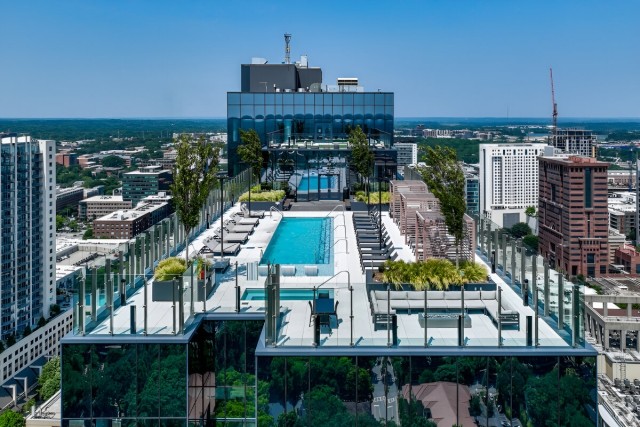Trying to find an apartment can be stressful, especially when you aren’t sure what you’re looking for or how much you can afford. If this will be your first apartment, it can even be a little bit scary. Moving is all about putting one foot in front of the other (and soon you’ll be walking out the door, as the classic children’s song goes). Here are 10 easy steps to finding an apartment so you can walk out that door with confidence.
1: Determine Your Budget
This step is critical. Your happiness and security hinges on getting this part right. Okay, that’s a little bit dramatic, but it’s true. If you end up in a place you can barely afford, you won’t have money for fun events, evenings out, food … and that undue stress of trying to make ends meet isn’t healthy. So let’s get this part right.
The amount you should spend on rent should be no more than 30 percent of your income. Use your net income – the actual amount of your paycheck – rather than your gross income (the amount before taxes and deductions are taken out). If you follow the 50/30/20 rule for budgeting, this allows you to spend 50 percent of your income on bills (including rent) and necessities, 30 percent on yourself (dinner out, a new pair of shoes, etc.), and 20 percent on savings. Make sure the rent comes out of the 50 percent and that you have enough left for utilities and other payments (car, credit cards, insurance).
Once you’ve determined the amount you can comfortably spend on rent, write it down. Commit it to memory. Post it on your fridge. Whatever it takes to remind yourself not to go over that amount. This is critical because once you begin your apartment search, you might get caught in the trap of falling in love with a place you can’t actually afford. Unless you want to find a roommate to share the costs, let’s avoid that trap.
2: Get Your Credit Score
Curtail surprises when you get to the leasing office by knowing your credit score. You can get a free credit report from annualcreditreport.com. This is the only official site for credit reports. Some sites will ask for credit card information – avoid those. Knowing your credit score before you start searching for apartments is important because, if your credit is less than stellar, you can take steps now to either repair it (especially if there’s an error on your report) or find a cosigner or guarantor.
3: Shop for Renters Insurance
Renters insurance is an inexpensive way to protect your belongings. The national average is $15-$30 a month and it covers your belongings if they are destroyed in a covered event (like a fire) or are stolen. Some policies even cover your hotel costs if your rental property was damaged to the point of being uninhabitable (such as by fire). It typically includes liability protection, just in case someone is injured in your apartment. Many apartment communities – and even some private landlords – require renters insurance. Start shopping around now so you can compare rates and make an informed decision. You’ll want to secure a policy a day or two before moving into your new apartment.
If you already have renters insurance, let them know you are planning to move as soon as possible – your coverage should transfer with you to your new place and will typically cover your new place for up to 30 days after you move in. Your premiums will be adjusted to appropriately cover your new place, so make allowances for that.
4: Define Your Desired Location
Where do you want to live? It seems like a fairly simple question to answer until you start thinking of all the pros and cons of certain cities and neighborhoods. Do you want to be within walking distance to work? Do you want a quiet suburban community or a trendy urban neighborhood? How important are commute times? What about schools? Do you want to be close to friends and family? Are restaurants and nightlife important to you? Whew! There’s a lot to unpack here. If you use Apartments.com, the answers to these questions may be easier to find. You can read about cities and neighborhoods, view pictures, look at walk scores and schools, and plan your commute.
Narrow down your choices by comparing the pros and cons of each location and weigh what’s most important to you. For example, if you aren’t interested in schools but you want to be within a five-minute walk to work, some neighborhoods will be quickly eliminated. Read up on each of the remaining neighborhoods and make sure these areas fit your lifestyle and your budget.
5: Select Your Must-Have Amenities
Let’s be honest: the amenities are one of the top reasons to rent. But, unless you have an unlimited budget and amazing luck, you probably won’t find an apartment with every feature on your wish list. Write down all of the amenities that you want in your apartment: swimming pool, tennis court, dog park, movie theater, granite countertops – whatever. Then go back and put a star next to the ones you can’t live without. From those you’ve starred, decide which ones are deal-breakers. For example, if you have a dog, then “pet-friendly” will be an absolute must-have, while others might fall off as less important. As you search for apartments, use the filter feature to see only apartments with your desired amenities (and within your price range because we determined that already, as well).
6: Choose Your Favorites
At this point, you should have a list of apartments within your price range in your desired location and with your must-have amenities. If you are conducting your search on Apartments.com, you can save your favorites by clicking the heart on the property’s listing. Now, it’s time to compare. View them side-by-side by using the renter’s tools on Apartments.com or jot down the pros and cons for each place. Take some virtual tours if they’re provided. Apartments.com offers 3D tours so you can “walk through” and get a feel for the apartment and the community. (Am I the only one who does this regularly, even when not apartment-hunting? Virtual tours are fun!)
For the places that have more cons than pros, scratch those off your list. Keep doing this until you have it narrowed down to your top three to five.
7: Call Properties and Schedule Tours
Call your top contenders and verify availability. This is a crucial part of your apartment search, especially if you live in an area where apartments are snapped up quickly. What may have been available when you began searching may be gone by the time you call. That’s why it’s important to have a few finalists on your list. If the apartment is available, schedule a tour. Do this for each apartment on your short list. While virtual tours give you a great understanding of the layout and features, visiting in person gives you a better understanding of the neighborhood, the building’s layout, and the apartment’s actual size, finishes, and functionality.
8: Go on Tours!
This is the fun part! There are some things you should be aware of as you go on apartment tours. You’ll want to ask lots of questions during these tours, so take a notebook and pen and jot down everything you find noteworthy. As you walk through, take plenty of pictures to go with your notes. Don’t make the mistake of renting the first apartment you see! Even if you are in a market where apartments move quickly, don’t feel pressured to make a decision until you are absolutely sure. Try to tour at least two or three apartment communities so you can compare.
Some things you should consider on your apartment tour:
- Is the kitchen large enough?
- Do the drawers and cabinets open freely? Do they hit the counter behind them?
- Open the oven. Make sure there’s room to get around it.
- How are the appliances? Is there a dishwasher?
- Will you have enough storage space? How big are the closets?
- Is there plenty of natural light?
- How are the views?
- Will your furniture fit?
- How’s the water pressure? (Turn on the shower and flush the toilet!)
- Can you get a signal on your cell phone?
- Be quiet and listen. Can you hear the neighbors?
- Are the parking areas and breezeways well-lit?
- Will you have an assigned parking space? Is there enough guest parking?
- Is there a sprinkler system?
- Where are the smoke detectors?
- If there’s an air conditioner, does it work?
- Are there enough power outlets?
9: Make Your Decision and Submit Your Application
Armed with photos and notes from your apartment tours, it’s time to sit down and decide. You can do this on your own or invite some friends or family over to help you – it always helps to have different perspectives, and they might see something you overlooked. If you need to, go back for another tour with a friend or family member – this is especially helpful if you aren’t sure or are torn between two options. When you know for sure which place you want, submit your application. Some places allow you to do this online. If not, you’ll go to the leasing office. You’ll likely be required to pay an application fee, so take some form of payment with you.
10: Go to the Rental Office
You get the call and you’re approved! Congratulations! Before you dash off, take stock and make sure you have everything you need. Dress nicely. No, it isn’t a job interview and you don’t need a suit, but don’t schlep to the leasing office in ripped jeans and a stained sweatshirt, either. Aim for professional yet casual. Now go, armed with knowledge about what the rental application process involves. You’ll want to bring a few things with you. The typical items include a paystub, a photo ID, and bank statements. You’ll also want to bring some form of payment for the security deposit and other fees. Read the lease carefully, ask any questions you may have, and sign the lease!
It doesn’t matter if this is your first apartment or you 21st. The process is always a little bit intimidating, but hopefully these ten small steps will get you closer to that door. Good luck on your apartment-hunting journey!
Published February 21, 2020






